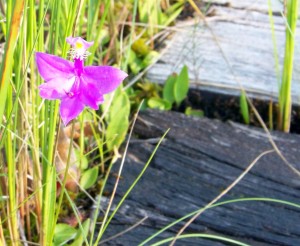
Fortunately for the bog, not just anyone is willing to go on the hunt unless they have a purpose, for me personally, that mission is to go on the hunt for some of the most amazing and/or rare wildflowers in the State.
As a one time employee of Hartwick Pines State Park, where I was employed as a ranger, I have developed a passion for this incredible ecosystem despite the constant barrage of mosquitoes. Wildflowers specific to bog ecosystems are found throughout this bog and as with any ecosytem, are constantly changing. I have been going to this particular bog for over 10 years now, though admittedly, until this year, it had been a couple of years. The change in it were stunning. The eye is getting smaller, the grasses and sedges denser and the trees moving in. A bog is constantly changing, not at a rapid rate, but without human disturbance, times march will eventually change a bog into rich soils which will support an entirely different ecosystem.
Watching how the bog changes without the impact of non natives is a special experience indeed. I have not yet been disappointed with what I have seen and as I get older, find myself even more inspired by its stunning variety and beauty.
We are extremely lucky as this are is not yet invaded by non-native or invasive species and is, as a whole, a pristine ecosystem, still growing and blooming with the same flowers that have bloomed here for generations.
This year’s treks to the bog have also not disappointed. While talking about pitcher plants to a fellow artist, who happened to be painting one at the time, I mentioned the bog. It was the beginning of June and my immediate thought was ORCHIDS! Yes orchids. In fact, three species to be exact. Each protected, each stunning and each found in our very own bog. I headed right out after that in the hopes that I wasn’t too late.
Upon arrival at about 7 pm, I emerged from a dense canopy of black spruce, balsam fir, cedar and tamaracks into the light. Sun sinking in the horizon the vast sea of pink flowers blanketing the bog were highlighted by the orange-red of the sun’s weakening rays. I had indeed, not missed it. More orchids than I could ever remember virtually coated the mat, and the song of the white throated sparrow and the hermit thrush welcomed me back with open arms.
I sat for a while in quiet contemplation, reminiscing of times long past, times when class work and summer jobs were my only worries. After the mosquitoes attack snapped me out of my happy place, I took some pictures of the blooms. Round Leaved Sundew, Rose Pogonia, Grass Pink, Pitcher Plants, Marsh Cinquefoil, Horned-Bladderwort and Small Bog Cranberry were everywhere. Though most bog flowers tend to be pink or red, if you look closely, you can see yellows, and whites as well.
The number of flowers living in a bog is quite vast and very specific to the area, offering those in search of great subjects for photography, a perfect location. If you have never been to a bog, find one. Enjoy the beauty. Get down on the ground and really study the flowers, they are truly intricate and illustrate the beauty of nature.
I leave you with this….
The best remedy for those who are afraid, lonely or unhappy is to go outside, somewhere where they can be quiet, alone with the heavens, nature and God.
Because only then does one feel that all is as it should be and that God wishes to see people happy, amidst the simple beauty of nature. I firmly believe that nature brings solace in all troubles.
– ~Anne Frank